Adi Alhudhaif
Multimodal joint prediction of traffic spatial-temporal data with graph sparse attention mechanism and bidirectional temporal convolutional network
Dec 24, 2024



Abstract:Traffic flow prediction plays a crucial role in the management and operation of urban transportation systems. While extensive research has been conducted on predictions for individual transportation modes, there is relatively limited research on joint prediction across different transportation modes. Furthermore, existing multimodal traffic joint modeling methods often lack flexibility in spatial-temporal feature extraction. To address these issues, we propose a method called Graph Sparse Attention Mechanism with Bidirectional Temporal Convolutional Network (GSABT) for multimodal traffic spatial-temporal joint prediction. First, we use a multimodal graph multiplied by self-attention weights to capture spatial local features, and then employ the Top-U sparse attention mechanism to obtain spatial global features. Second, we utilize a bidirectional temporal convolutional network to enhance the temporal feature correlation between the output and input data, and extract inter-modal and intra-modal temporal features through the share-unique module. Finally, we have designed a multimodal joint prediction framework that can be flexibly extended to both spatial and temporal dimensions. Extensive experiments conducted on three real datasets indicate that the proposed model consistently achieves state-of-the-art predictive performance.
Emotional Speaker Identification using a Novel Capsule Nets Model
Jan 09, 2022

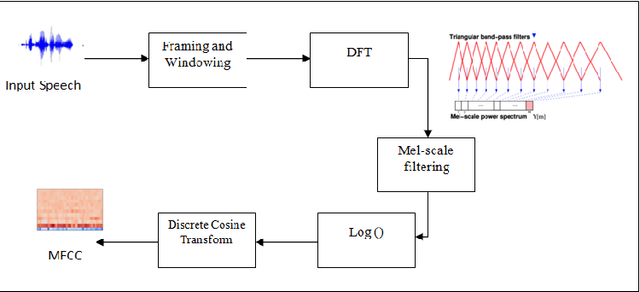

Abstract:Speaker recognition systems are widely used in various applications to identify a person by their voice; however, the high degree of variability in speech signals makes this a challenging task. Dealing with emotional variations is very difficult because emotions alter the voice characteristics of a person; thus, the acoustic features differ from those used to train models in a neutral environment. Therefore, speaker recognition models trained on neutral speech fail to correctly identify speakers under emotional stress. Although considerable advancements in speaker identification have been made using convolutional neural networks (CNN), CNNs cannot exploit the spatial association between low-level features. Inspired by the recent introduction of capsule networks (CapsNets), which are based on deep learning to overcome the inadequacy of CNNs in preserving the pose relationship between low-level features with their pooling technique, this study investigates the performance of using CapsNets in identifying speakers from emotional speech recordings. A CapsNet-based speaker identification model is proposed and evaluated using three distinct speech databases, i.e., the Emirati Speech Database, SUSAS Dataset, and RAVDESS (open-access). The proposed model is also compared to baseline systems. Experimental results demonstrate that the novel proposed CapsNet model trains faster and provides better results over current state-of-the-art schemes. The effect of the routing algorithm on speaker identification performance was also studied by varying the number of iterations, both with and without a decoder network.
Novel Hybrid DNN Approaches for Speaker Verification in Emotional and Stressful Talking Environments
Dec 26, 2021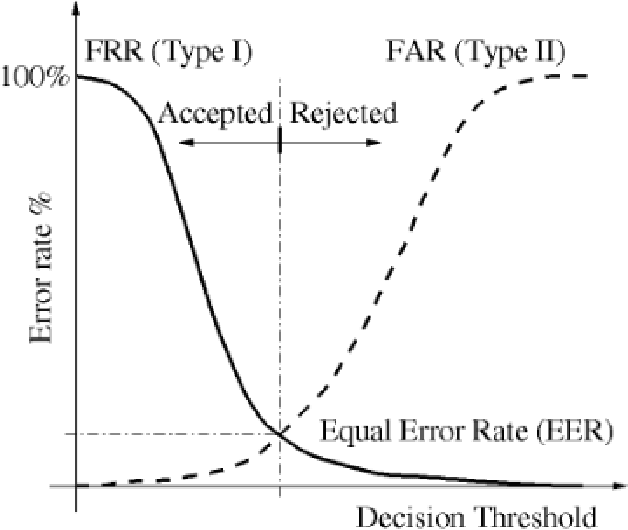
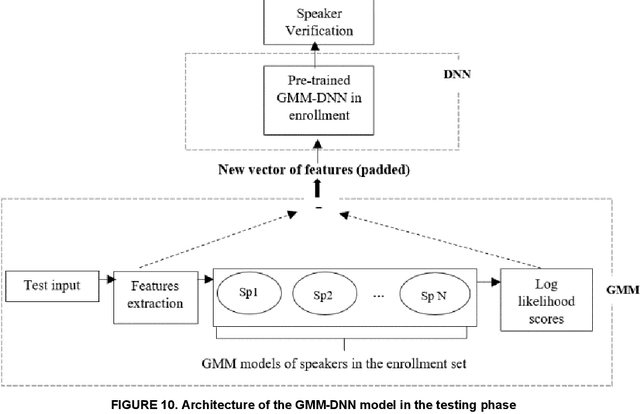
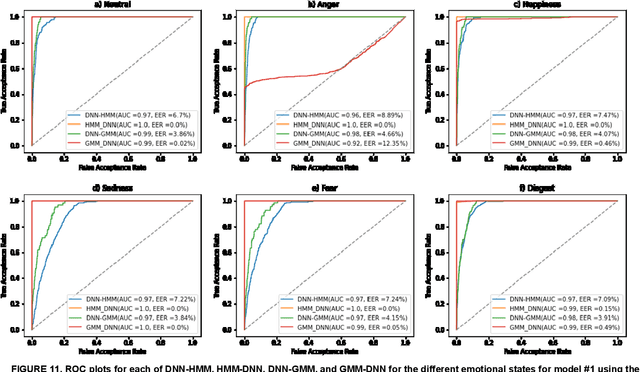
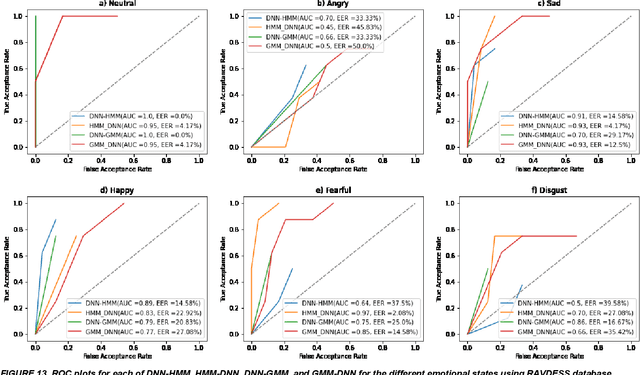
Abstract:In this work, we conducted an empirical comparative study of the performance of text-independent speaker verification in emotional and stressful environments. This work combined deep models with shallow architecture, which resulted in novel hybrid classifiers. Four distinct hybrid models were utilized: deep neural network-hidden Markov model (DNN-HMM), deep neural network-Gaussian mixture model (DNN-GMM), Gaussian mixture model-deep neural network (GMM-DNN), and hidden Markov model-deep neural network (HMM-DNN). All models were based on novel implemented architecture. The comparative study used three distinct speech datasets: a private Arabic dataset and two public English databases, namely, Speech Under Simulated and Actual Stress (SUSAS) and Ryerson Audio-Visual Database of Emotional Speech and Song (RAVDESS). The test results of the aforementioned hybrid models demonstrated that the proposed HMM-DNN leveraged the verification performance in emotional and stressful environments. Results also showed that HMM-DNN outperformed all other hybrid models in terms of equal error rate (EER) and area under the curve (AUC) evaluation metrics. The average resulting verification system based on the three datasets yielded EERs of 7.19%, 16.85%, 11.51%, and 11.90% based on HMM-DNN, DNN-HMM, DNN-GMM, and GMM-DNN, respectively. Furthermore, we found that the DNN-GMM model demonstrated the least computational complexity compared to all other hybrid models in both talking environments. Conversely, the HMM-DNN model required the greatest amount of training time. Findings also demonstrated that EER and AUC values depended on the database when comparing average emotional and stressful performances.
* 23 pages, 13 figures
Novel Dual-Channel Long Short-Term Memory Compressed Capsule Networks for Emotion Recognition
Dec 26, 2021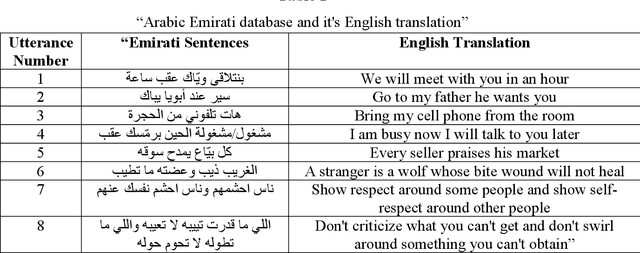
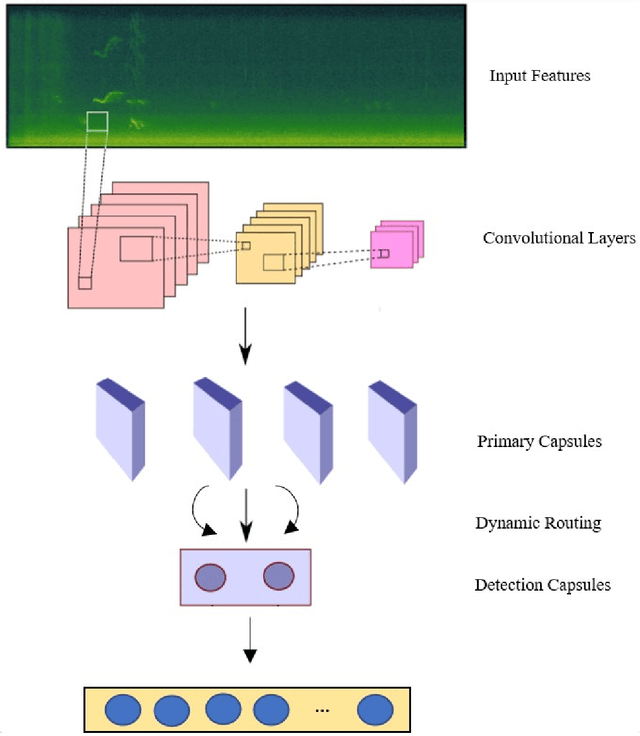


Abstract:Recent analysis on speech emotion recognition has made considerable advances with the use of MFCCs spectrogram features and the implementation of neural network approaches such as convolutional neural networks (CNNs). Capsule networks (CapsNet) have gained gratitude as alternatives to CNNs with their larger capacities for hierarchical representation. To address these issues, this research introduces a text-independent and speaker-independent SER novel architecture, where a dual-channel long short-term memory compressed-CapsNet (DC-LSTM COMP-CapsNet) algorithm is proposed based on the structural features of CapsNet. Our proposed novel classifier can ensure the energy efficiency of the model and adequate compression method in speech emotion recognition, which is not delivered through the original structure of a CapsNet. Moreover, the grid search approach is used to attain optimal solutions. Results witnessed an improved performance and reduction in the training and testing running time. The speech datasets used to evaluate our algorithm are: Arabic Emirati-accented corpus, English speech under simulated and actual stress corpus, English Ryerson audio-visual database of emotional speech and song corpus, and crowd-sourced emotional multimodal actors dataset. This work reveals that the optimum feature extraction method compared to other known methods is MFCCs delta-delta. Using the four datasets and the MFCCs delta-delta, DC-LSTM COMP-CapsNet surpasses all the state-of-the-art systems, classical classifiers, CNN, and the original CapsNet. Using the Arabic Emirati-accented corpus, our results demonstrate that the proposed work yields average emotion recognition accuracy of 89.3% compared to 84.7%, 82.2%, 69.8%, 69.2%, 53.8%, 42.6%, and 31.9% based on CapsNet, CNN, support vector machine, multi-layer perceptron, k-nearest neighbor, radial basis function, and naive Bayes, respectively.
* 19 pages, 11 figures
 Add to Chrome
Add to Chrome Add to Firefox
Add to Firefox Add to Edge
Add to Edge